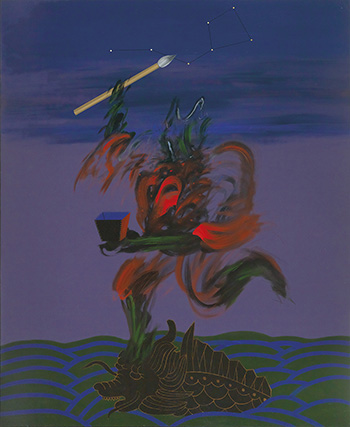PROVENANCE:
Cherng Piin Gallery (Eslite Gallery), Taipei Dimensions Art Center, Taipei
Private collection, Asia
EXHIBITED:
Yan Hsia: Continuation and Rejuvenation. A Retrospective of His Works from 1954 to 1994 , Taipei Fine Arts Museum, Taipei, April 30-June 12, 1994
Retrospective of Hsia Yan From 1954 to 1998 , Taiwan Museum of Art, Taichung, December 11, 1998-January 10, 1999
ILLUSTRATED:
Yan Hsia: Continuation and Rejuvenation. A Retrospective of His Works from 1954 to 1994 , Taipei Fine Arts Museum, Taipei, 1994, color illustrated, p. 83
Retrospective of Hsia Yan From 1954 to 1998 , Taiwan Museum of Art, Taichung, 1999, color illustrated, no. 54
Catalogue Note:
THE GOD OF ACHIEVEMENTS
HSIA YAN
Hsia Yan, who had once studied under master artist Li Zhong-Sheng, founded the Ton Fan Art Group with Hsiao Chin, Huo Gang, and Wu Hao in the 1950s, and was a member of the “Eight Great Outlaws.” In 1963, Hsia Yan moved to Paris to study Western art and began creating the extremely unique Fuzzy People series. In just a short span of two years, he was able to hold his first solo exhibition at the Galerie du Haut Pavé of Paris; these earlier works were primarily influenced and inspired by Mechanism, Expressionism, and Surrealism. In his thirst for knowledge, Hsia Yan moved to New York in 1968 and came under the influence of the photorealism movement which was on trend at that time. He used his paint brush to capture the precise details of the New York street scenes and depicted the pedestrians as blurry silhouettes as if their images had been shot using long exposure photography. Throughout the next two decades or so, Hsia Yan's works were exhibited in numerous art museums and galleries around the US; it was due to the exquisitely realistic details portrayed in his works that Hsia Yan succeeded in making a name for himself on the New York art scene.
From the 1990s onwards, Hsia Yan began shifting his creative focus to traditional folklores and folk crafts. Having experienced years of constant relocation among three different continents, Hsia Yan was able to look in from an outsider's perceptive and search anew for the roots of Chinese traditional culture and art. The artist’s choice of Chinese mythologies as his creative subjects nonetheless revealed his longing for home, and indeed, he subsequently decided to move back to Taiwan in 1992. The God of Achievements,” created in 1990, features a mythological figure based on and evolved from the style he had previously adopted for the creation of the Fuzzy People series early in his career. The God of Achievements painted upon the canvas has retained the blurry outlines distinctive of the Fuzzy People, while the backdrop remains unchanged from those of the artist’s New York era. With the change of time and space, a balance has been created between the stillness and movement of the image.
The traditional mythological character Kui Xing (literally 'Chief Star), or God of Achievements, is usually depicted the same way as he has been within the artwork--holding a pen in his right hand and an ink seal in his left, his left leg kicks backward towards a star in the Big Dipper constellation (hence the name Kui Xing) while his right foot steps on the head of a turtle to signify success and attainment. From an astrological point of view, Kui is the first star in the Big Dipper and has therefore since the ancient times been the deity worshiped by students and scholars who pray for top rankings in examinations. Hsia Yan uses these folklore characters to depict a world of even more profound depth. Through the mythical figures that have been imbued with formless powers by worshipers, and through the forms of representation for the obscure and abstract, Hsia Yan explores the relationship between reality and imagination and the interconnection between the body and soul. Although this work is expressed through Western mediums, one can see in the overall composition that division of foreground, middle ground, and background corresponds to the principles of Chinese shanshui painting. The foreground consists of simple wave-like patterns while the main focus of this section is the partially-exposed turtle with its dragon-like head and fish-like body, an animal of immovable serenity as it rises out of the billowing ocean waves. The middle ground of the image consumes one-third of the entire painting, in which the distinctive contours of Kui Xing are depicted using blurred, quivering brushstrokes. Since the only two objects of stillness are the ink seal and the paint brush, the viewer's gaze is drawn naturally to the Big Dipper constellation at the top of the image. These intricate details created by the paint brush seem to be hints left by Hsia Yan in the painting, revealing to the viewers the plot of the story inherent.
